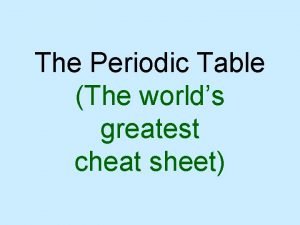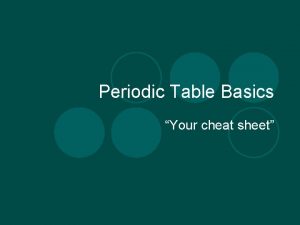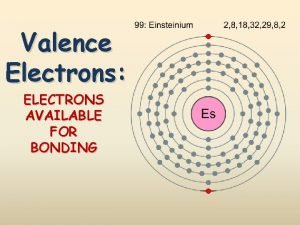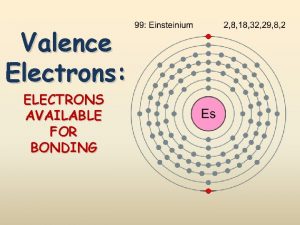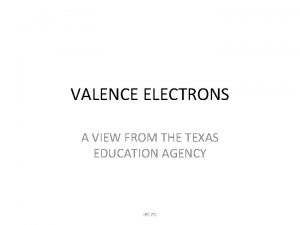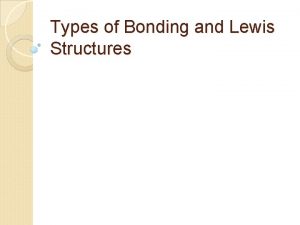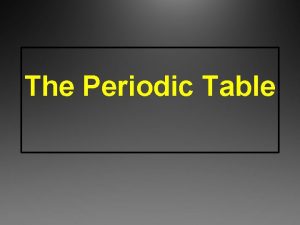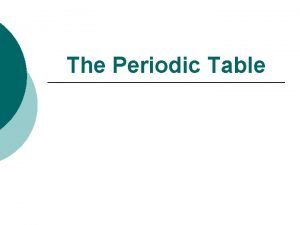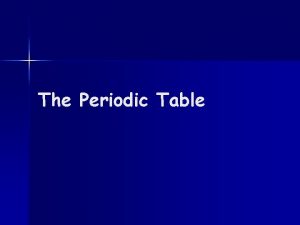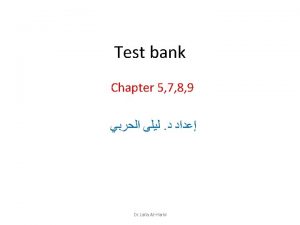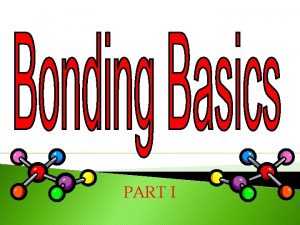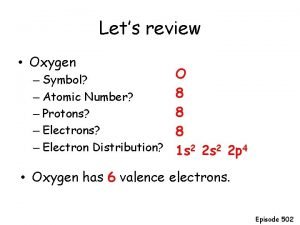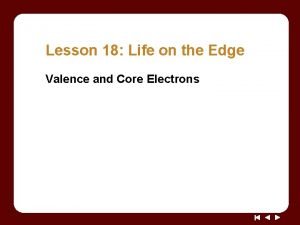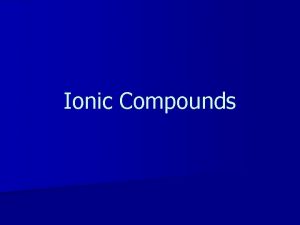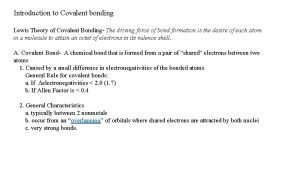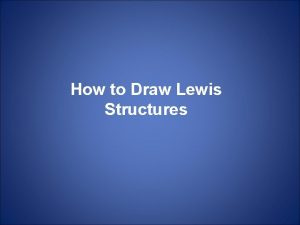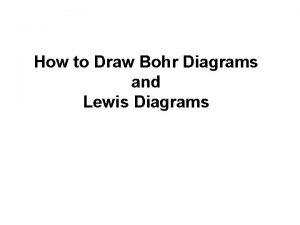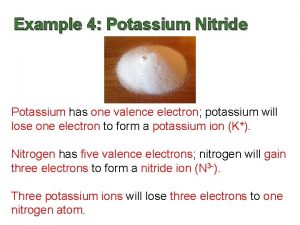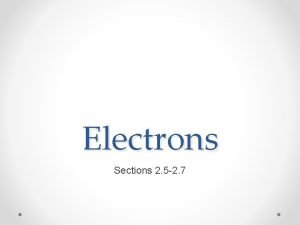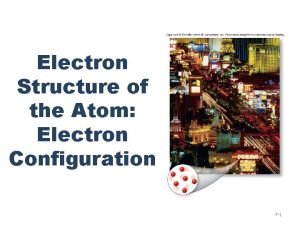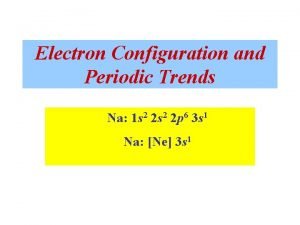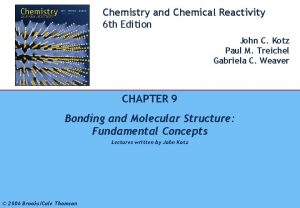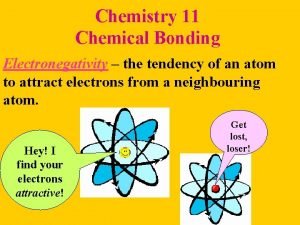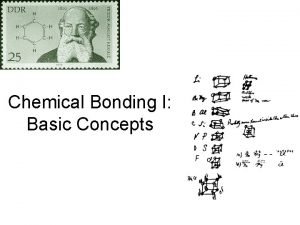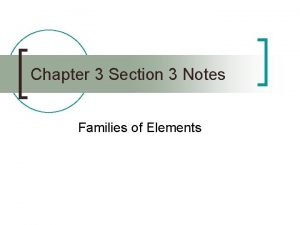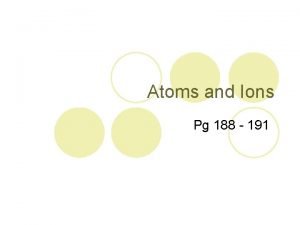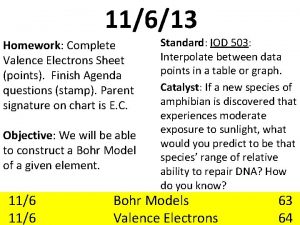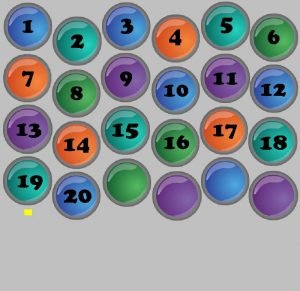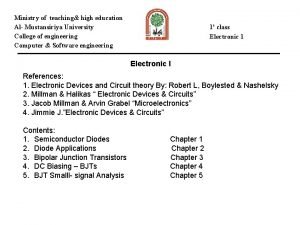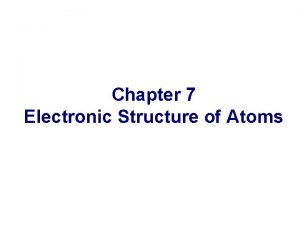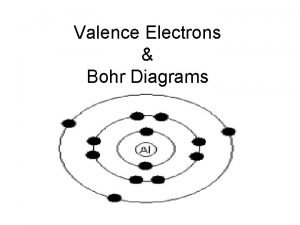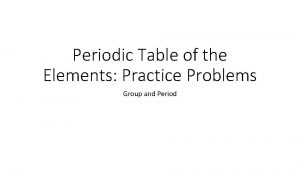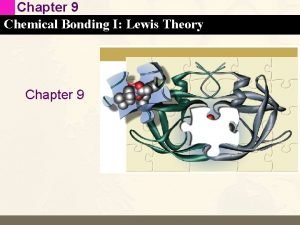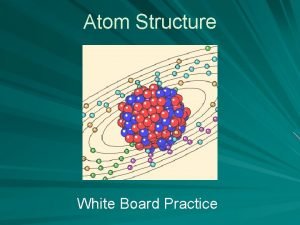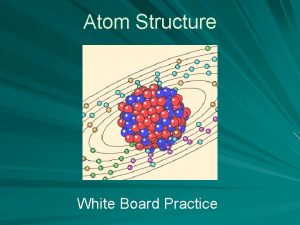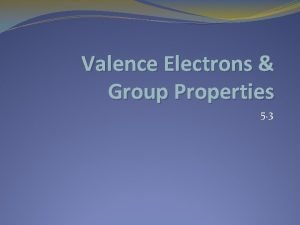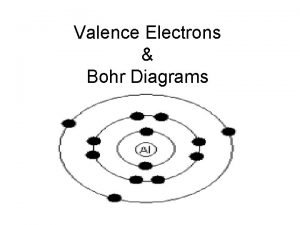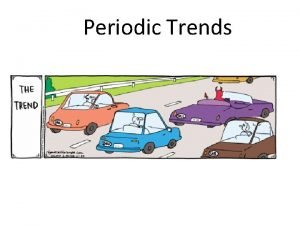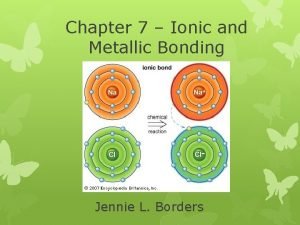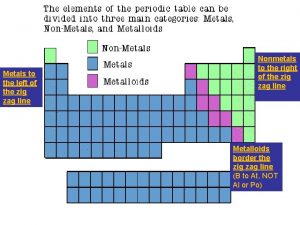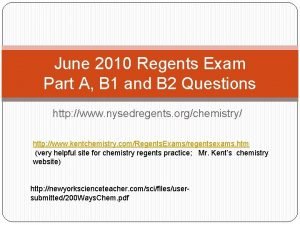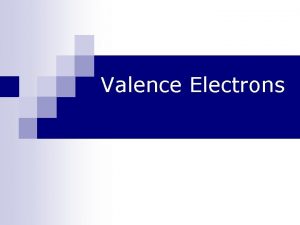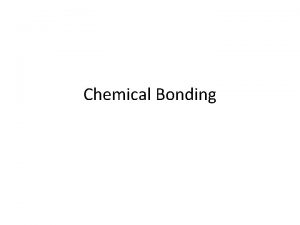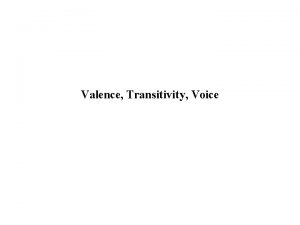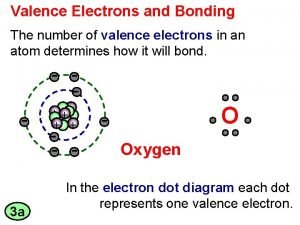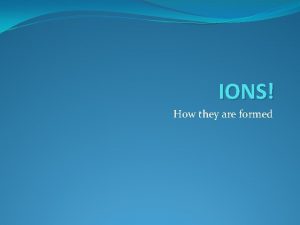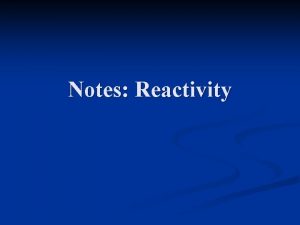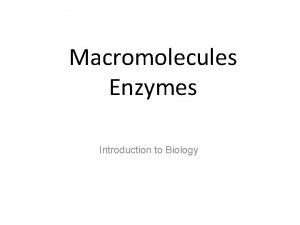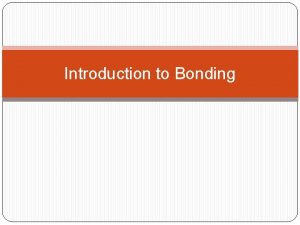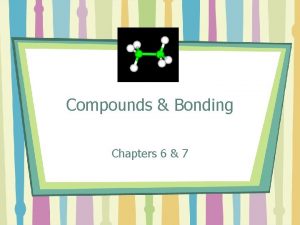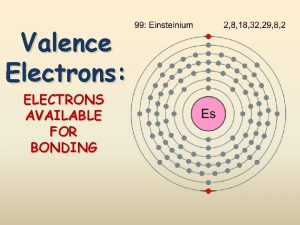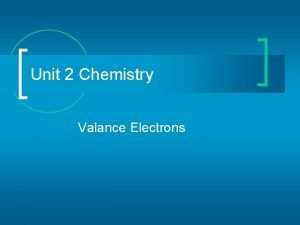11613 Homework Complete Valence Electrons Sheet points Finish





















































- Slides: 53

11/6/13 Homework: Complete Valence Electrons Sheet (points). Finish Agenda questions (stamp). Parent signature on chart is E. C. Objective: We will be able to construct a Bohr Model of a given element. 11/6 Standard: IOD 503: Interpolate between data points in a table or graph. Catalyst: If a new species of amphibian is discovered that experiences moderate exposure to sunlight, what would you predict to be that species’ range of relative ability to repair DNA? How do you know? Bohr Models Valence Electrons 63 64

Announcements • Today is the last day of the quarter! • No school tomorrow!

Agenda • Catalyst • Announcements • HW Review • Finish Yesterday’s Notes • Bohr Models • Start Valence Worksheet

HW Review 1. Element made of only one type of atom Made up of all the same type of particle Compound made of all the same types of atoms Made of atoms Contain multiple types of atoms Mixture Made of a combination of multiple atoms or compounds

HW Review 2. proton: positive particle in the nucleus of the atom. Neutron: neutral particle in the nucleus of the atom. Electron: negatively charged particle moving around the outside of the nucleus. 3. a. 8. 4 x 1023 atoms b. 2 x 1021 atoms c. 3. 6 x 1023 atoms d. 4. a. A, D, H b. C c. B, E d. none e. G

HW Review 5. They’re both a mixture of different particles. Homogenous the particles are evenly mixed and cannot be seen. Heterogeneous the particles are not evenly mixed and can be seen. 6. Homo: A, C, E, F, H Hetero: B, D, G

Classification of Matter 62

Review Copy this table into your notes! Elements Compounds Mixtures

Review Glucose (C 6 H 12 O 6) Elements Compounds Mixtures

Review Elements Compounds Glucose (C 6 H 12 O 6) Mixtures

Review Platinum (Pt) Elements Compounds Glucose (C 6 H 12 O 6) Mixtures

Review Elements Platinum (Pt) Compounds Glucose (C 6 H 12 O 6) Mixtures

Review Pure Water (H 2 O) Elements Platinum (Pt) Compounds Glucose (C 6 H 12 O 6) Mixtures

Review Pure Water (H 2 O) Elements Platinum (Pt) Compounds Glucose (C 6 H 12 O 6) Pure Water (H 2 O) Mixtures

Review Sea Water Elements Platinum (Pt) Compounds Glucose (C 6 H 12 O 6) Pure Water (H 2 O) Mixtures

Review Elements Platinum (Pt) Compounds Glucose (C 6 H 12 O 6) Pure Water (H 2 O) Mixtures Sea Water

Review Kool-Aid Elements Platinum (Pt) Compounds Glucose (C 6 H 12 O 6) Pure Water (H 2 O) Mixtures Sea Water

Review Elements Platinum (Pt) Compounds Glucose (C 6 H 12 O 6) Pure Water (H 2 O) Mixtures Sea Water Kool-Aid

Review Neptunium (Np) Elements Platinum (Pt) Compounds Glucose (C 6 H 12 O 6) Pure Water (H 2 O) Mixtures Sea Water Kool-Aid

Review Elements Platinum (Pt) Neptunium (Np) Compounds Glucose (C 6 H 12 O 6) Pure Water (H 2 O) Mixtures Sea Water Kool-Aid

Review Sand Elements Platinum (Pt) Neptunium (Np) Compounds Glucose (C 6 H 12 O 6) Pure Water (H 2 O) Mixtures Sea Water Kool-Aid

Review Elements Platinum (Pt) Neptunium (Np) Compounds Glucose (C 6 H 12 O 6) Pure Water (H 2 O) Mixtures Sea Water Kool-Aid Sand

Review • A pure substance is when all of the particles are identical. • Two main types: –Elements: made up of only one type of atom – Compounds: made up of all the same group of atoms.

Mixtures • A mixture is when you have different types of particles present. • Two main types: –Homogeneous Mixture –Heterogeneous Mixture

Mixtures • A homogeneous mixture is when particles are evenly distributed throughout. –Examples: coffee, laundry detergent, Jello

Mixtures • A heterogeneous mixture is when particles are not evenly distributed throughout. –Examples: mixed nuts, oil and water, soil

Recap Which of the mixtures we identified earlier were homogeneous mixtures? Heterogenous mixtures? Elements Platinum (Pt) Neptunium (Np) Compounds Glucose (C 6 H 12 O 6) Pure Water (H 2 O) Mixtures Sea Water Kool-Aid Sand

Bohr Models 63

Review 15 P Phosphorus 30. 97 Atomic Number = # of Protons # Protons = # Electrons # Protons = 15 Atomic Symbol # Neutrons = 16 # Electrons = 15 Atomic Mass = Protons + Neutrons Rounded Mass - # Protons = # Neutrons

Atom Video • We know electrons move around the nucleus in the electron cloud. • https: //www. youtube. com/watch? v=l. P 57 g. EW cis. Y • But a 3 -D model is hard to draw…

Bohr Models • Rutherford’s model of the atom couldn’t explain why unique colors were obtained by atoms of different elements when heated. • Bohr proposed that electrons are in orbits and when excited they jump to a higher orbit. When they fall back to the original orbit, they give off light.

Bohr's model: -electrons orbit the nucleus like planets orbit the sun

-It takes energy for an atom to hold onto an electron, so each orbit can hold a specific maximum number of electrons

orbit 1 2 3 4 maximum # electrons 2 8 18 32

Bohr’s Model of the Atom • Electrons fill orbits closest to the nucleus first. • The electrons in the outermost level are known as VALENCE electrons.

Example: Bohr's Model of the Atom Fluorine. : #P = #e- = #N =

Example: Bohr's Model of the Atom Fluorine: #P = atomic # =9 #e- = #N =

Example: Bohr's Model of the Atom Fluorine: #P = 9 #e- = # P =9 #N =

Example: Bohr's Model of the Atom Fluorine: #P = 9 #e- = 9 #N = atomic mass - # P = 10

Example: Bohr's Model of the Atom Fluorine: #P = 9 #e- = 9 #N = 10 9 P 10 N Draw the nucleus with protons & neutrons

Example: Bohr's Model of the Atom Fluorine: #P = 9 #e- = 9 #N = 10 9 P 10 N How many electrons can fit in the first orbit?

Example: Bohr's Model of the Atom Fluorine: #P = 9 #e- = 9 #N = 10 9 P 10 N How many electrons can fit in the first orbit? 2

Example: Bohr's Model of the Atom Fluorine: #P = 9 #e- = 9 #N = 10 How many electrons are left? 9 P 10 N

Example: Bohr's Model of the Atom Fluorine: #P = 9 #e- = 9 #N = 10 How many electrons are left? 9 P 10 N 7

Example: Bohr's Model of the Atom Fluorine: #P = 9 #e- = 9 #N = 10 9 P 10 N How many electrons are left? How many electrons fit in the second orbit? 7

Example: Bohr's Model of the Atom Fluorine: #P = 9 #e- = 9 #N = 10 9 P 10 N How many electrons are left? How many electrons fit in the second orbit? 7 8

Example: Bohr's Model of the Atom Fluorine: #P = 9 #e- = 9 #N = 10 9 P 10 N How many valence electrons are present? 7

Whiteboard Practice • Draw each atom on your whiteboard.

Bohr's Model of the Atom Hydrogen 1 P 0 N How many valence electrons are present?

Bohr's Model of the Atom Boron 5 P 6 N How many valence electrons are present?

Bohr's Model of the Atom Magnesium 12 P 12 N How many valence electrons are present?

Valence Electrons WS • This worksheet is homework if not finished in class.

 Periodic table cheat sheet
Periodic table cheat sheet Periodic trends cheat sheet
Periodic trends cheat sheet What is a valence electron? *
What is a valence electron? * Valence electrons for transition metals
Valence electrons for transition metals Group with 6 valence electrons
Group with 6 valence electrons Valence electrons of each group
Valence electrons of each group Valence electrons group 1
Valence electrons group 1 S22- lewis structure
S22- lewis structure What is z on the periodic table
What is z on the periodic table Tarantola periodic table
Tarantola periodic table Nitrogen valence electrons
Nitrogen valence electrons Selenium unpaired electrons
Selenium unpaired electrons Atoms with 4 valence electrons
Atoms with 4 valence electrons Finding valence electrons
Finding valence electrons Triple bond symbol
Triple bond symbol Life on the edge valence and core electrons
Life on the edge valence and core electrons How is positive ion formed
How is positive ion formed Scn- lewis structure
Scn- lewis structure How to find the number of protons in an element
How to find the number of protons in an element Orbital diagram
Orbital diagram How to draw valence electrons
How to draw valence electrons The bohr model for helium
The bohr model for helium C2f4 lewis structure
C2f4 lewis structure Potassium nitride lewis structure
Potassium nitride lewis structure 1s 22 s22 p63
1s 22 s22 p63 4p7 electron configuration
4p7 electron configuration Electron configuration for na+1
Electron configuration for na+1 Sulfite ion valence electrons
Sulfite ion valence electrons Hnhh molecule
Hnhh molecule Nf3 lewis
Nf3 lewis Halogens valence electrons
Halogens valence electrons Valence electrons in cf4
Valence electrons in cf4 Valence electrons of helium
Valence electrons of helium Valence electrons of each group
Valence electrons of each group P valence electrons
P valence electrons Which region contains the halogen family of elements?
Which region contains the halogen family of elements? Outer electrons
Outer electrons The diffused impurities with
The diffused impurities with Vanadium number of valence electrons
Vanadium number of valence electrons Valence electrons bohr diagram
Valence electrons bohr diagram Electron shell
Electron shell General formula of alkanes
General formula of alkanes Bohr model of calcium
Bohr model of calcium Valence electrons abbreviation
Valence electrons abbreviation How many valence electrons does barium (ba) have? *
How many valence electrons does barium (ba) have? * How many valence electrons does barium (ba) have? *
How many valence electrons does barium (ba) have? * 5 valence electrons group
5 valence electrons group Valence electrons bohr diagram
Valence electrons bohr diagram Atomic radius of sulfer
Atomic radius of sulfer Oxegen valence electrons
Oxegen valence electrons How do chemists model the valence electrons of metal atoms?
How do chemists model the valence electrons of metal atoms? Metallic bond formula
Metallic bond formula Atomic radius defintion
Atomic radius defintion Argon valence electrons
Argon valence electrons
